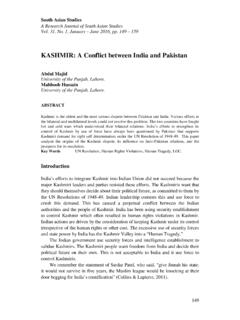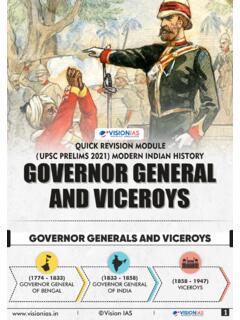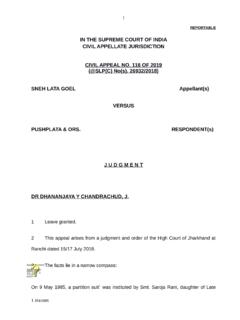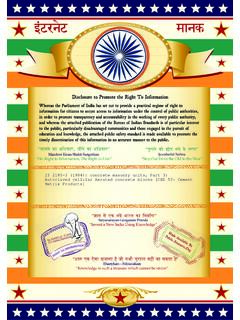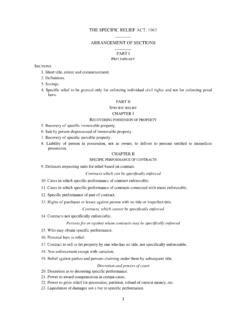Transcription of J U D G M E N T A.S. Bopanna,J. - Supreme Court of India
1 REPORTABLE IN THE Supreme Court OF India CIVIL APPELLATE JURISDICTION CIVIL APPEAL NO. 1892 OF 2020 (Arising out of SLP (Civil) of 2015)Jose ..Appellant(s)VersusJohnson .. Respondent(s)J U D G M E N Bopanna,J. Leave granted. 2. The appellant herein is before this Court assailingthe judgment dated passed by the High Courtof Kerala in FAO (RO) Through the saidjudgment the High Court allowed the appeal, set asidethe judgment dated passed by the FirstAppellate Court in AS and restored thejudgment and decree passed by the Trial Court in Page 1 of Since the rank of the parties wasdescribed differently in the said proceedings the partieswill be referred in the rank assigned to them in the trialcourt in the original suit for the sake of convenience andclarity.
2 The appellant herein was the defendant, whilethe respondent herein was the plaintiff in the suit. Theywill be referred chronology of the events is that the plaintifffiled the suit bearing in the Court ofthe Munsiff at Aluva seeking for judgment and decree ofpermanent prohibitory injunction in respect of the suitschedule property. The defendant appeared and fileddetailed written statement disputing the claim of theplaintiff. Based on the rival pleadings the trial courtframed issues, the parties tendered evidence and the trialcourt decreed the suit through its judgment The defendant claiming to be aggrieved bythe same preferred an appeal under Section 96 of CivilProcedure Code ( CPC for short)
3 In Page 2 of 13 The First Appellate Court on reappreciating the matter,through its judgment dated set aside thejudgment dated passed by the trial Court and remanded the suit to the trialcourt for fresh disposal in terms of the directions it was a remand in terms of order 41 Rule 23 ACPC, the plaintiff preferred an appeal to the High Courtin FAO (RO) as contemplated under Order43 Rule 1(W) of CPC. The High Court through itsjudgment dated has allowed the appeal andrestored the judgment and decree passed by the trialcourt.
4 The defendant, therefore, claiming to be aggrievedis before this Court in this brief facts are that the plaintiff claimed right inrespect of the property bearing Resurvey (oldSurvey , 517/1 in Block 28 measuring 15 Are in Vadakkumbhagom, Aluva Taluk, SreemoolanagaramSub District, Ernakulam under a Partition Deed 2007 being a cousin of the defendant , the fathers Page 3 of 13of the plaintiff and defendant being brothers. Thecause for the suit was stated to be the obstructioncaused by the defendants when the plaintiff was in the process of constructing a wall onthe eastern side.)
5 The nature of the incident is referredand, in that background, prayed for permanentprohibitory injunction. The plaintiff examined himselfand relied upon the documents at Exhibits A1 to A6. TheReport of the Court Commissioner and the sketch weremarked as Exhibits C1 and C1(a). The defendant did nottender any evidence or produce documents. trial Court while answering the issues has heldthat the property is identifiable and the plaintiff is theowner in possession of the suit schedule property. Inthat light on answering the issues in favour of theplaintiff has decreed the suit. In the appeal filed by thedefendant the lower appellate Court while reappreciatingthe evidence has taken into consideration the contentionput forth by the defendant with regard to the nature of Page 4 of 13the property and the manner in which the property hadbeen partitioned in the year 1964.
6 The Court had alsotaken note that in such circumstance the plaintiff hadnot made any effort to identify the property nor was thedefendant provided sufficient opportunity to prove theirclaim. The lower appellate Court also took note that anapplication in had been filed by thedefendant under Order 41 Rule 27 for producing thecertified copy of the Partition Deed it was concluded that the suit was tried in ahurry without appropriately identifying the propertyalong with its measurement. In that circumstance, thelower appellate Court on finding that the matter requiresreconsideration had set aside the decree and remandedthe the appeal filed by the plaintiff before the HighCourt, the High Court on taking note that the suit wasfor perpetual injunction only and in that light since thepossession of the plaintiff not being in serious dispute, Page 5 of 13was of the opinion that the title to the property was notrelevant.
7 In that circumstance, the High Court was of theopinion that the learned Judge of the lower appellatecourt was not justified in arriving at the conclusion thatthe property is to be measured on the basis of the titledeed. In that view, the High Court has set aside thejudgment of the lower appellate Court and restored thedecree passed by the trial Court . 7. Heard Shri Noor Muhamed, learned advocatefor the appellant, Mr. Sreekumar, learned senioradvocate for the respondent and perused the noted the lower appellate Court has set asidethe judgement, remanded the matter and permitted thedefendant to file the application under Order 41 Rule 27 CPC before the trial Court and has permitted the partiesto tender further evidence so as to enable theidentification of the plaint schedule property with theassistance of the Taluk Surveyor and thereafter arrive at Page 6 of 13the conclusion.
8 Per contra, the High Court on takingnote that the suit is for bare injunction has found thatthe exercise to identify the property with reference to theownership is not justified. learned senior advocate for the plaintiff whilesubmitting in support of the conclusion reached by theHigh Court would contend that the law is well establishedthat in a suit for bare injunction the proof of title wouldnot be necessary and the relevant circumstance wouldonly be the possession relating to the property. Amongothers, the learned senior advocate has relied on thedecision of this Court in the case of Ravinder KaurGrewal & Ors.
9 Vs. Manjit Kaur & Ors. (2019) 8 SCC729 wherein the relevance of possession including thepossession claimed adverse to the interest of the owner isalso considered. In that light, it is contended by thelearned senior advocate that in such circumstance whenthe possession had been established before the trialcourt, the trial Court was justified in granting the decree. Page 7 of 13 The High Court , therefore, has appropriately restoredsuch decree and the same does not call for interference inthis appeal is his contention.
10 Learned advocate for the defendant wouldhowever contend that the very nature of the rivalcontentions put forth in the suit would indicate that thevery claim to the property relating to the portion whereinthe wall was being constructed was disputed by thedefendant and in that light when appropriate issues wereframed by the trial Court , the manner in which the wallwas being constructed cannot be considered as being ona property where the plaintiff was in lawful settledpossession. The very fact that the plaintiff had notsought for declaration of his right over the property whenhis right was under challenge would make the suit itselfnot maintainable.
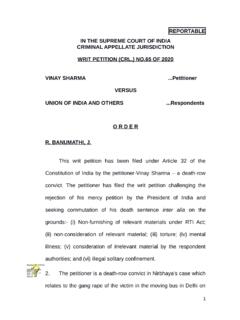
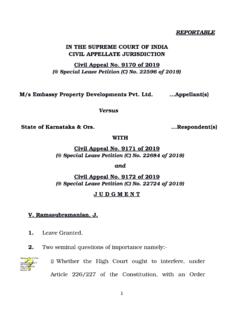
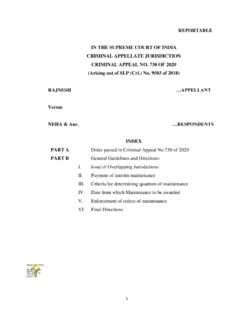
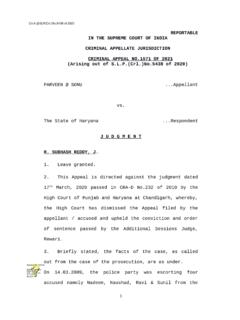
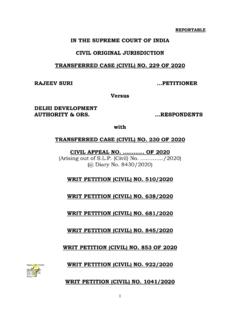
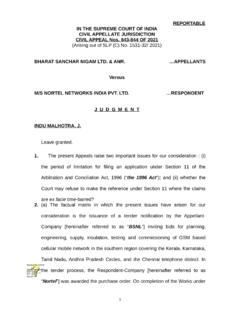
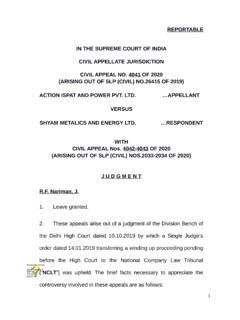
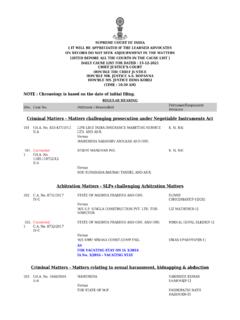
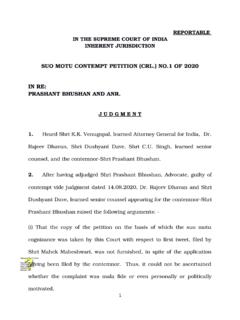
![[DEFAULT / OTHER MATTERS] [SERVICE/COMPLIANCE] …](/cache/preview/4/8/a/c/d/7/0/e/thumb-48acd70e206083f8f3d37421a64ec859.jpg)
